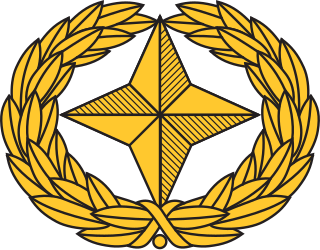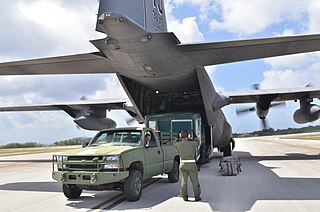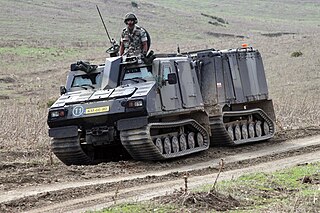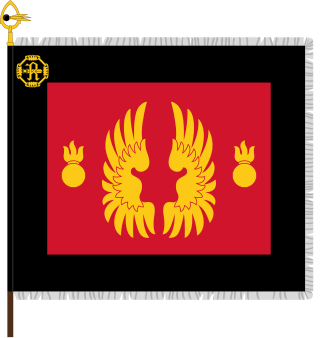
The Patria Pasi is a Finnish-made six-wheeled armoured personnel carrier (APC) originally designed for Finnish Defence Forces. The first variant was produced in 1983 and serial production began in 1984. It was designed to operate with ease of use, simple structure and low-cost maintenance. The basic appearance and configuration of the Pasi is similar to most other wheeled APCs. The XA-180 and XA-185 are fully amphibious, while other variants are not.

Ski warfare is the use of ski-equipped troops in war.

The Jaeger Brigade (Jääkäriprikaati) is a unit of the Finnish Army. The unit is located in Sodankylä and Rovaniemi in Finnish Lapland, some 130 kilometres (81 mi) north of the Arctic Circle. The brigade trains 2,200 conscripts per year. The brigade has two main units: Lapland Jaeger Battalion in Sodankylä and Rovaniemi Air Defence Battalion at Rovaniemi air base.

Bandvagn 206 is a tracked articulated, all-terrain carrier initially developed and manufactured by the Swedish company Hägglund & Söner, and subsequently by BAE Systems Hägglunds, for the Swedish Army. It consists of two units, with all four tracks powered. It can carry up to 17 people, 6 in the front compartment, 11 in the rear. The trailer unit can be adapted for different uses.

The Soltam K6 is a 120 mm mortar that was developed by Soltam Systems of Israel. It is the long-range version of the Soltam K5 and has replaced older systems, such as the 107-millimetre (4.2 in) M30, in several armies, including the United States Army. It is much lighter than the M30, has a greater range, and can sustain a rate of fire of four rounds per minute, while the M30 could sustain only three.

The Snow Trac is a small personal Snowcat that is roughly the size of a modern compact car. Aktiv Snow Trac were manufactured in Sweden between 1957 and 1981, with additional vehicles manufactured in Scotland.

Bandvagn 202 is an amphibious oversnow tracked articulated, all-terrain vehicle developed by Bolinder-Munktell, a subsidiary of Volvo, for the Swedish Army in the early 1960s.

The Commercial Utility Cargo Vehicle, later the Light Service Support Vehicle (LSSV), is a vehicle program instituted to provide the United States military with light utility vehicles based on a civilian truck chassis.

ASRAD-R is a vehicle-mounted short-range air defense system, designed by a joint German-Swedish effort between Rheinmetall and Saab Bofors Dynamics. The system is modular and can be mounted on almost any wheeled or tracked vehicle. It has for instance been demonstrated mounted on an M113 armoured personnel carrier.

The BvS10 is a tracked articulated amphibious all-terrain armoured vehicle produced by BAE Systems Land Systems Hägglunds of Sweden. This vehicle, referred to as the All Terrain Vehicle (protected) - ATV(P) or Viking by the UK forces, was originally developed as a collaboration between industry - Hägglunds Vehicle AB - and the British Ministry of Defence (MoD) on behalf of the Royal Marines.

Raupenschlepper Ost was a fully tracked, lightweight vehicle used by the Wehrmacht in World War II. It was conceived in response to the poor performance of wheeled and half-tracked vehicles in the mud and snow during the Wehrmacht's first autumn and winter on the Soviet Front.

The Bronco All Terrain Tracked Carrier (ATTC) is a twin chassis multi-purpose tracked articulated vehicle jointly developed by ST Kinetics and the Defence Science and Technology Agency (DSTA) for the Singapore Army. A variant of the Bronco in British service in Afghanistan was named Warthog.

The 120 KRH 92 is a 120 mm mortar manufactured in Finland.

Kainuu Artillery Regiment is an artillery unit of the Kainuu Brigade, which is the northernmost one of the three readiness brigades of the Finnish Defence Forces.
The Patria Pasi is a military armoured personnel carrier. It was the choice of the Finnish Defence Forces to replace its aging Soviet BTR-60s. It was a result of the commercial competition between two Finnish companies, a tractor manufacturer Valmet and the lorry manufacturer Sisu, which won the contract with its prototype.

Sisu SA-240 is a heavy off-road lorry made by the Finnish heavy vehicle manufacturer Oy Sisu-Auto Ab from 1984 until 1991. The six-wheel drive lorry with payload of 12,000 kg was developed for pulling of heavy cannons of the Finnish Defence Forces.

Sisu K-44 is a three-axle 4×4+2 driven lorry made by the Finnish heavy vehicle manufacturer Suomen Autoteollisuus (SAT) from 1959 to 1965. The most usual applications were for log transportation and earth moving vehicles. The K-44 was noted for its excellent gradient capabilities. The legally permissible maximum vehicle payload was between 7 800 and 11 750 kg: with a trailer this increased to 20 000 kg. The K-44s were powered by Leyland diesel engines with power outputs of between 85.8 and 156.7 kW.

Sisu E13TP is a military terrain truck produced by the Finnish heavy vehicle producer Sisu Defence. The vehicle was introduced in 2005 and the first vehicles were delivered in 2007. E13TP is available in layouts 6×6 and 8×8. The stronger variant E15TP is with 10×10 layout.

Dongfeng Mengshi was originally a family of 4×4 MRAP/off-road vehicles developed by Dongfeng Motor Group. Early generations of the vehicle are built with imported Hummer H1 chassis, while later generations of the vehicles are of indigenous design. Dongfeng Mengshi generally follows the trend of American military requirements. For example, CSK-141 is the Chinese equivalent of an armor-plated reinforced Humvee, while CSK-181 is the Chinese equivalent of the Joint Light Tactical Vehicle.

A tracked articulated vehicle or articulated tracked vehicle, is a variation of a continuous track vehicle that consists of two cars, each with their own track, most commonly with an actuated linkage in between. This configuration allows an articulated tracked vehicle to turn by articulating the swivel joint in between the two vehicles, as opposed to using differential steering to move one track faster than the other.




















